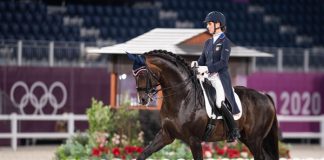
No matter what the obstacle—for horse or rider—grids, often called gymnastics, can help you troubleshoot and refine your skills.
Frank Madden, head trainer at Old Salem Farm in North Salem, N.Y., has been working with horses for the past 45 years. He was named the United States Olympic Committee Coach of the Year in both 2004 and 2006. Madden says grids can help horses and riders work on some of the basics without the anxiety that often accompanies jumping.
Grid Guidelines
Madden recommends building a grid out of simple materials, such as rails and cavallettis. Gates and walls are not necessary for a functional grid. And take caution to not overuse grids in your training program.
“Use grids to help develop confidence, straightness, timing and continuity,” says Madden. “The most important thing in any exercise, especially in a grid, is to protect your horse’s confidence.” Ultimately, grid work can help a horse develop a more consistent style to his jump.
Grids for Greenies
Grids can be beneficial for horses of any age, but they have several particular advantages for young horses; for example, the chance to experience continuity.
Madden advises avoiding any kind of tricky situation that could make a young horse feel trapped. The last thing you want to do is cause him to fail and scare himself.
“Design the grid to be natural to the horse’s stride,” says Madden. “The initial placement of the jumps should be set up in a very comfortable fashion.” When your horse is familiar with the simple grid, you can begin to tailor it to his more specific needs.

A standard first grid is three trot poles or cavalletti on the ground with a distance of 3 to 4 feet in between them, followed by a small cross-rail at a distance of 9 to 10 feet from the third pole or cavalletti.
“It’s really important to understand that while it might look easy, it can be an extremely difficult task [depending on the] horse,” says Madden.
Get your horse comfortable trotting through this set-up before you add more jumps.
Next, if you’re not dealing with stops or runouts, leave the cross-rail to help your horse stabilize himself at the trot, and then add a low vertical after it (with a ground line) at a distance of 18 to 20 feet from the cross-rail. You should have one canter stride between the cross-rail and vertical. Madden recommends basing everything off of a 12-foot canter stride, so 18 to 20 feet will allow 3 to 4 feet for the landing from the cross-rail and the takeoff to the vertical.
If you find that your horse has a refusal or a runout at any point in the grid, Madden recommends you take a step or two back in the process to help your young horse regain his confidence. You can lean a small rail against a standard at the problematic jump to create a chute effect in an effort to prevent a runout. If you do this, take your horse through the entire grid, not just a single jump.
Grids for the Experienced Horse
If you’re incorporating grids into your rides with a more advanced horse, first establish a particular area of focus. Madden says timing is a good skill to work on.
Start with the grid Madden uses for the green horse. If you set up the 18-foot distance between the cross-rail and vertical, you create a short, active stride to the vertical. You could also remove the ground line to increase the challenge of the exercise.
If your horse is comfortable with this grid, Madden suggests you add an oxer 20 to 23 feet away from the vertical. If that goes well, set up another vertical 32 to 33 feet away from the oxer. You’re going to ask your horse for two short strides between the oxer and the next vertical.
“It’s really important for riders to understand that the grid can have many different effects on a horse,” says Madden. “It’s not something that’s going to do all the work for you. So much still has to come from the rider and how the rider is influencing the horse through that grid.”
Madden cautions that while the grid can be set up to be safe and positive, it can also be set up the wrong way and become very detrimental.
When working with a more advanced horse, you can begin to raise the height of the jumps. The height should be determined by the skill level of you and your horse, and the focus of your exercise. Still, use caution and don’t overface your horse.
“I would rather make it more [challenging] for a horse by manipulating the distance than the height of a jump,” says Madden. “For example, make the distance tighter than normal in a two-stride.”
Remember when planning grid work to always focus on the horse’s confidence and setting him up to be successful.

Grids for Riders
Grids are also incredibly beneficial for riders. Because they’re structured in a straight line, they give you an opportunity to work on your position and balance.
“Grids can really take a lot of the anxiety out of jumping because the grid helps with timing,” says Madden. Once you guide your horse into the grid, it will regulate his speed and straightness. By taking this task off your plate, you can focus on your position and other details.
“No matter what exercise you do on a horse, it’s a gymnastic,” says Madden. Every ride should have a focus, and you should always be working toward building your horse’s confidence and setting him up for success.
Special thanks to Jane Papke and her Thoroughbred, Norman, for demonstrating these exercises at Scheffelridge Farm in Paris, Ky.
This article originally appeared in the August 2014 issue of Horse Illustrated magazine. Click here to subscribe!






